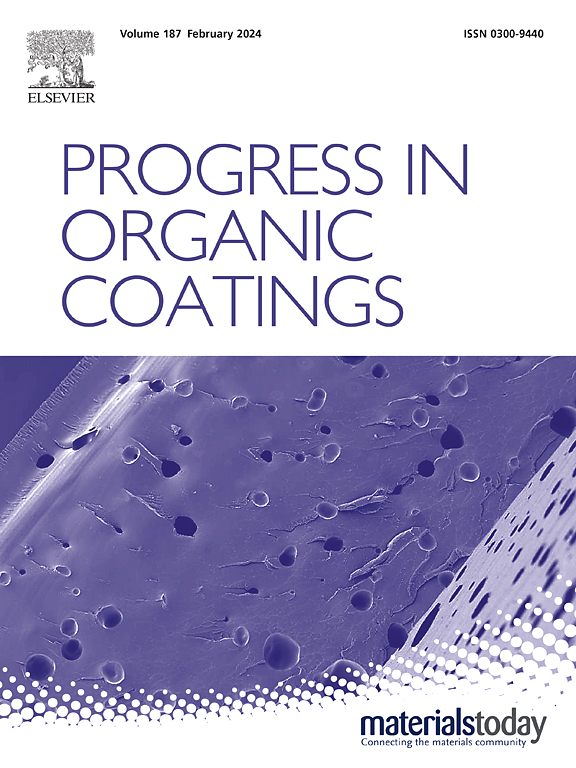磺化石墨烯增强水性腰果酚环氧涂料:绿色合成和卓越的耐腐蚀性
IF 6.5
2区 材料科学
Q1 CHEMISTRY, APPLIED
引用次数: 0
摘要
随着全球对环境保护和可持续发展的日益重视,开发环境友好型防腐涂料已成为材料科学领域的一个重要研究方向。本研究基于绿色化学原理,成功开发了一种集环保与优异防护性能于一体的水性生物基环氧防腐涂料。该涂层以腰果酚类环氧树脂为原料,采用相转化乳化工艺,以磺化石墨烯(SG)为纳米填料合成。采用NMR、FTIR、XRD、XPS、SEM对材料进行表征,并通过力学性能测试、电化学阻抗谱(EIS)和盐雾测试来评价SG含量对涂层综合性能的影响。实验结果表明,与其他配方相比,添加0.5 wt% SG的涂层体系具有更好的力学性能和耐腐蚀性。实验结果表明,当SG含量为0.5 wt%时,涂层的低频阻抗(|Z|0.01 Hz)达到2.96 × 109 Ω·cm2,比未改性的涂层提高了一个数量级。此外,即使在EIS测试720小时后,阻抗仍然稳定在这个高水平。此外,在360 h的盐雾划痕试验中,该涂层的腐蚀扩展最不明显,表明该涂层体系具有优异的防腐性能。本研究为高性能、环保型防腐涂料的开发提供了新的设计思路和技术途径。本文章由计算机程序翻译,如有差异,请以英文原文为准。
Sulfonated graphene-reinforced waterborne cardanol epoxy coatings: Green synthesis and exceptional corrosion resistance
With the growing global emphasis on environmental protection and sustainable development, the development of environmentally friendly anti-corrosion coatings has become a significant research direction in the field of materials science. Based on the principles of green chemistry, this study successfully developed a waterborne bio-based epoxy anti-corrosion coating that combines environmental friendliness with outstanding protective performance. The coating was synthesized using cardanol-derived epoxy resin as the raw material, employing a phase inversion emulsification process, and incorporating sulfonated graphene (SG) as a nanofiller. The materials were characterized using NMR, FTIR, XRD, XPS, and SEM, while mechanical property tests, electrochemical impedance spectroscopy (EIS), and salt spray tests were conducted to evaluate the influence of SG content on the coating's comprehensive performance. Experimental results indicate that the coating system with 0.5 wt% SG exhibited improved mechanical properties and corrosion resistance compared to other formulations. The experimental results demonstrate that when the SG content is 0.5 wt%, the low-frequency impedance (|Z|0.01 Hz) of the coating reaches 2.96 × 109 Ω·cm2, which is one order of magnitude higher than that of the unmodified coating. Moreover, the impedance remains stable at this high level even after 720 h of EIS testing. Additionally, during the 360-h scratch salt spray test, this coating exhibits the least noticeable corrosion propagation, indicating that the coating system possesses excellent anti-corrosion performance. This study provides novel design insights and technical pathways for the development of high-performance, environmentally friendly anti-corrosion coatings.
求助全文
通过发布文献求助,成功后即可免费获取论文全文。
去求助
来源期刊

Progress in Organic Coatings
工程技术-材料科学:膜
CiteScore
11.40
自引率
15.20%
发文量
577
审稿时长
48 days
期刊介绍:
The aim of this international journal is to analyse and publicise the progress and current state of knowledge in the field of organic coatings and related materials. The Editors and the Editorial Board members will solicit both review and research papers from academic and industrial scientists who are actively engaged in research and development or, in the case of review papers, have extensive experience in the subject to be reviewed. Unsolicited manuscripts will be accepted if they meet the journal''s requirements. The journal publishes papers dealing with such subjects as:
• Chemical, physical and technological properties of organic coatings and related materials
• Problems and methods of preparation, manufacture and application of these materials
• Performance, testing and analysis.
 求助内容:
求助内容: 应助结果提醒方式:
应助结果提醒方式:


